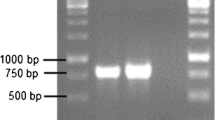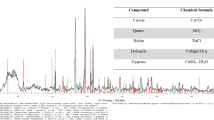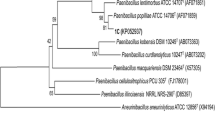Abstract
A hydrocarbon degrading and biosurfactant producing, strain DHT2, was isolated from oil-contaminated soil. The organism grew and produced biosurfactant when cultured in variety of substrates at salinities up to 6 g l−1 and temperatures up to 45°C. It was capable of utilizing crude oil, fuels, alkanes and PAHs as carbon source across the wide range of temperature (30–45°C) and salinity (0–6%). Over the range evaluated, the salinity and temperature did not influence the degradation of hydrocarbon and biosurfactant productions. Isolate DHT2 was identified as Pseudomonas aeruginosa by analysis of 16S rRNA sequences (100% homology) and biochemical analysis. PCR and DNA hybridization studies revealed that enzymes involved in PAH metabolism were related to the naphthalene dioxygenase pathway. Observation of both tensio-active and emulsifying activities indicated that biosurfactants were produced by DHT2 during growth on both, water miscible and immiscible substrates, including PAH. The biosurfactants lowered the surface tension of medium from 54.9 to 30.2 dN/cm and formed a stable emulsion. The biosurfactant produced by the organism emulsified a range of hydrocarbons with hexadecane as best substrate and toluene was the poorest. These findings further indicate that the isolate could be useful for bioremediation and bio-refining application in petroleum industry.






Similar content being viewed by others
References
Arino S, Marchal R, Vandecasteele J-P (1996) Identification and production of a rhamnolipidic biosurfactant by a Pseudomonas species. Appl Microbiol Biotechnol 45:162–168
Barkay T, Navon-Venezia S, Ron EZ, Rosenberg E (1999) Enhancement of solubilization and biodegradation of polyaromatic hydrocarbons by the bioemulsifier alasan. Appl Environ Microbiol 65:2697–2702
Beal R, Betts WB (2000) Role of rhamnolipid biosurfactants in the uptake and mineralization of hexdecane by hydrocarbon assimilation and biosurfactant producing Pseudomonas aeruginosa. J Appl Microbiol 89:158–168
Benincasa M, Abalos A, Oliveira I, Manresa A (2004) Chemical structure, surface properties and biological activities of the biosurfactant produced by Pseudomonas aeruginosa LBI from soapstock. Antonie Van Leeuwenhoek 85:1–8
Bertrand JC, Almallah M, Acqaviva M, Mille G (1990) Biodegradation of hydrocarbons by an extremely halophilic archaebacterium. Lett Appl Microbiol 11:260–263
Bodour AA, Drees KP, Maier RM (2003) Distribution of biosurfactant-producing bacteria in undisturbed and contaminated arid southwestern soils. Appl Environ Microbiol 69:3280–3287
Borgne SL, Quintero R (2003) Biotechnological processes for refining of petroleum. Fuel Process Technol 81:155–169
Braford MM (1976) A rapid and sensitive method for the quantitation of microgram quantities of protein utilizing the principle of protein dye binding. Anal Chem 72:248–254
Cameotra SS, Makkar R (1998) Synthesis of biosurfactants in extreme conditions. Appl Microbiol Biotechnol 50:520–529
Cameotra SS, Makkar RS (2004) Recent applications of biosurfactants as biological and immunological molecules. Curr Opin Microbiol 7:1–5
Cassidy DP, Hudak AJ (2001) Microorganism selection and biosurfactant production in a continuously and periodically operated bioslurry reactor. J Hazard Mater 84:253–264
Chen WP, Kuo TT (1993) A simple and rapid method for the preparation of gram-negative bacterial genomic DNA. Nucleic Acids Res 21:2260
Das K, Mukherjee AK (2005) Characterization of biochemical properties and biological activities of biosurfactants produced by Pseudomonas aeruginosa mucoid and non-mucoid strains isolated from hydrocarbon-contaminated soil samples. Appl Microbiol Biotechnol 69:192–199
Das M, Das SK, Mukherjee RK (1998) Surface-active properties of the culture filtrates of a Micrococcus species grown on n-alkanes and sugars. Bioresour Technol 63:231–235
Desai JD, Banat IM (1997) Microbial production of surfactants and their commercial potential. Microbiol Mol Biol Rev 61:47–64
Deziel E, Paquette G, Villemur R, Lepine F, Bisaillon JG (1996) Biosurfactant production by a soil Pseudomonas strain growing on polycyclic aromatic hydrocarbons. Appl Environ Microbiol 62:1908–1912
Deziel E, Lepine F, Milot S, Villemur R (2003) rhlA is required for the production of anovel biosurfactant promoting swarming motility in Pseudomonas aeruginosa:3-(3-hydroxyalkanoyloxy) alkanoic acids (HAAs), the precursors of rhamnolipids. Microbiology 149:2005–2013
Diaz MP, Boyd KG, Grigson SJ, Burgess JG (2002) Biodegradation of crude oil across a wide range of salinities by an extremely halotolerant bacterial consortium MPD-M, immobilized onto polypropylene fibers. Biotechnol Bioeng 79:145–153
Ensley BD, Gibson DT (1983) Naphthalene dioxygenase: purification and properties of a terminal oxygenase component. J Bacteriol 155:505–511
Falatko DF, Novak JT (1992) Effects of biologically produced surfactants on the mobility and biodegradation of petroleum hydrocarbons. Water Environ Res 64:163–169
Habe H, Omori T (2003) Genetics of polycyclic aromatic hydrocarbon metabolism in diverse aerobic bacteria. Biosci Biotechnol Biochem 67:225–243
Ilori MO, Amund DI (2001) Production of a peptidoglycolipid bioemulsifier by Pseudomonas aeruginosa grown on hydrocarbon. Z Naturforsch C 56:547–552
Ilori MO, Amobi CJ, Odocha AC (2005) Factors affecting biosurfactant production by oil degrading Aeromonas spp. isolated from a tropical environment. Chemosphere 61:985–992
Kiyohara H, Nagao K, Yana K (1982) Rapid screen for bacteria degrading water-insoluble, solid hydrocarbons on agar plates. Appl Environ Microbiol 43:454–457
Kumar M, Leon V, Materano A, Ilzins OA, Galindo-Castro I, Fuenmayor SL (2006) Polycyclic aromatic hydrocarbon degradation by biosurfactant producing Pseudomonas sp. IR1. Z Naturforsch 61c:203–212
Kumar M, León V, Materano A, Ilzins OI (2007) A halotolerant and thermotolerant Bacillus sp. degrades hydrocarbons and produces tensio-active emulsifying agent. World J Microbiol Biotechnol 23:211–220
Leon V, Kumar M (2005) Biological upgrading of heavy crude oil. Biotechol Bioprocess Eng 10:471–481
Margesin R, Schinner F (2001) Potential of halotolerant and halophilic microorganisms for biotechnology. Extremophiles 5:73–83
Mille G, Almallah M, Bianchi M, Van Wambeke F, Bertrand JC (1991) Effect of salinity on petroleum biodegradation. Fresenius J Anal Chem 339:788–791
Niehaus F, Bertoldo C, Kahler M, Antranikian G (1999) Extremophiles as a source of novel enzymes for industrial application. Appl Microbiol Biotechnol 51:711–729
Noordman WH, Janssen DB (2002) Rhamnolipid stimulates uptake of hydrophobic compounds by Pseudomonas aeruginosa. Appl Environ Microbiol 68:4502–4508
Ochsner UA, Fiechter A, Reiser J (1994a) Isolation, characterization, and expression in Escherichia coli of the Pseudomonas aeruginosa rhlAB genes encoding a rhamnosyltransferase involved in rhamnolipid biosurfactant synthesis. J Biol Chem 269:19787–19795
Ochsner UA, Koch AK, Fiechter A, Reiser J (1994b) Isolation and characterization of a regulatory gene affecting rhamnolipid biosurfactant synthesis in Pseudomonas aeruginosa. J Bacteriol 176:2044–2054
Perfumo A, Banat IM, Canganella F, Marchant R (2006) Rhamnolipid production by a novel thermophilic hydrocarbon-degrading Pseudomonas aeruginosa AP02-1. Appl Microbiol Biotechnol 72:132–138
Rahman KSM, Banat IM, Thahira J, Thayumanavan T, Lakshmanaperumalsamy P (2002) Bioremediation of gasoline contaminated soil by a bacterial consortium amended with poultry litter, coir pith and rhamnolipid biosurfactant. Bioresour Technol 81:25–32
Rahman KSM, Rahman TJ, Kourkoutas Y, Petsas I, Marchant R, Banat IM (2003) Enhanced bioremediation of n-alkane in petroleum sludge using bacterial consortium amended with rhamnolipid and micronutrients. Bioresour Technol 90:159–168
Riss V, Kleinsteuber S, Babel W (2003) Influence of high salinities on the degradation of diesel fuel by bacterial consortia. Can J Microbiol 49:713–721
Rosenberg M, Rosenberg E (1985) Bacterial adherence at the hydrocarbon-water interface. Oil Petrochemical Pollut 2:155–162
Siegmund I, Wagner F (1991) New method for detecting rhamnolipids excreted by Pseudomonas species during growth on mineral agar. Biotechnol Tech 5:265–268
Soberon-Chavez G, Lepine F, Deziel E (2005) Production of rhamnolipids by Pseudomonas aeruginosa. Appl Microbiol Biotechnol 68:718–725
Spiro RG (1966) Analysis of sugar found in glycoproteins. Methods Enzymol 8:7–9
van der Gast CJ, Knowles CJ, Starkey M, Thompson IP (2002) Selection of microbial consortia for treating metal-working fluids. J Ind Microbiol Biotechnol 29:20–27
Youssef NH, Duncan KE, Nagle DP, Savage KN, Knapp RM, Mcinerney MJ (2004) Comparison of methods to detect biosurfactant production by diverse microorganisms. J Microbiol Methods 56:339–347
Acknowledgment
The authors wish to thanks to Dr R. K. Upreti, ITRC, Lucknow for critical appraisal of the manuscript.
Author information
Authors and Affiliations
Corresponding author
Rights and permissions
About this article
Cite this article
Kumar, M., León, V., De Sisto Materano, A. et al. Biosurfactant production and hydrocarbon-degradation by halotolerant and thermotolerant Pseudomonas sp.. World J Microbiol Biotechnol 24, 1047–1057 (2008). https://doi.org/10.1007/s11274-007-9574-5
Received:
Accepted:
Published:
Issue Date:
DOI: https://doi.org/10.1007/s11274-007-9574-5




